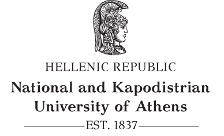- Αρχική
- THE PROGRAM
-
MODULES
- THE ARCHAEOLOGY OF BRONZE AGE AEGEAN (1010)
- KEY THEMES IN EASTERN MEDITERRANEAN ARCHAEOLOGY (1020)
- STATE FORMATION AND THE RISE OF POWER IN AN INSULAR WORLD: THE ARCHAEOLOGY OF MINOAN CRETE (3020)
- THE ARCHAEOLOGY OF MYCENAEAN GREECE (1050)
- COLLAPSE AND TRANSFORMATION: CRISIS, RESILIENCE, AND REORGANIZATION FROM THE LATE THIRD TO EARLY FIRST MILLENNIUM BCE IN THE EASTERN MEDITERRANEAN (3030)
- UNDERSTANDING THE ARCHAEOLOGICAL RECORD: PREHISTORIC CYPRUS AND THE EAST MEDITERRANEAN (2080)
- THE VISUAL CULTURES OF CLASSICAL GREECE (1030)
- ANCIENT GREEK SCULPTURE (1080)
- ATTIC POTTERY OF THE ARCHAIC AND CLASSICAL PERIODS (1090)
- THE ARCHITECTURE OF THE MYSTERY CULTS (2090)
- THE ARCHAEOLOGY OF DEATH IN THE ANCIENT GREEK WORLD (3010)
- STAFF
- ACTIVITIES
- ADMISSION
- RESOURCES
- CONTACT US
- NEWS AND EVENTS
STATE FORMATION AND THE RISE OF POWER IN AN INSULAR WORLD: THE ARCHAEOLOGY OF MINOAN CRETE (3020)
Spring Semester, Optional module, 10 ECTS.
Instructor: Yiannis Papadatos
Summary
This course is about the archaeology of prehistoric Crete, with special emphasis upon the Minoan palaces of the second millennium BC. The course includes an overview of major types of the Minoan material culture, such as settlements and domestic architecture, the palaces and their surrounding villas, major and minor arts and crafts such as pottery, frescoes, metal artefacts etc. In addition, the course is about the ways in which material remains may be informative of the structure and function of Minoan societies, their relations to the rest of the Aegean and the east Mediterranean, as well as of their beliefs and ritual practices. The course focuses particularly upon the palaces, namely court-centered buildings with ceremonial and administrative functions, suggesting the emergence of a complex society with sociopolitical hierarchies.
Learning outcomes
By the end of this course students should be familiar with:
- • the main Minoan sites and types of artefacts,
- • the main debates about social structure in Bronze Age Crete
- the main debates about the form, function, social significance and evolution of the Minoan palaces.
Syllabus
The course examines the following topics:
- Introduction and general spatial and temporal framework. History of research
- The Neolithic and the Prepalatial background to the Minoan palatial culture
- The dawn and formation of the Minoan palatial society
- Minoan palatial sites: the main features
- Settlement and non-funerary architecture
- Burial customs, funerary architecture, mortuary behavior
- Minoan palatial period: arts and crafts
- Writing, sealing, administration and the operation of the palace system
- Minoan iconography, religion and ritual
- The relations with the rest of the Aegean, and the issue of Minoanization
- Trade, exchange and political relations with the great powers of East Mediterranean
- Collapse of the palatial administration and post-palatial Crete
- 4-days field-trip in Crete and visit of the following sites: Knossos, Archanes, Phaistos, Ayia Triada, Tylissos, Malia, Gournia, Petras, Palaikastro, Zakros, Archaeological Museums of Heraklion and Siteia.
Assessment
*Essay: 70%
Oral presentation: 30%
*Participants are expected to produce one written essay (3.500-5.000 words) in English to be preceded by a mandatory oral presentation (also in English) during our penultimate or final meeting. Advice on the extent, scope and structure of the essay will be provided throughout the course in cooperation with the instructor. A list of indicative topics will be formulated, but students are strongly encouraged to discuss, modify or even propose any essay topic in collaboration with the course instructor.
Additionally, the quality of participation in discussions during the meetings will also be evaluated. Special presentations or discussions on select publications may also be assigned subject to an arrangement with the course instructor.
Student's study hours
Lectures: 26
Educational visits: 24
Study and analysis of bibliography: 70
Cooperation with the instructor: 20
Independent study (incl. project): 30
Essay writing: 80
Course total: 250
Recommended Bibliography
Andreadaki-Vlazaki, M., G. Rethemiotakis, N. Dimopoulou-Rethemiotaki 2008. From the Land of the Labyinth. Minoan Crete, 3000-1100 BC. New York - Athens: Alexander S. Onassis Public Benefit Foundation (USA).
Cline, E.H. (ed.) 2010. Oxford Handbook of the Aegean Bronze Age. Oxford: Oxford University Press (section sand chapters related to Crete).
Cullen, T. (ed.) 2001. “Aegean Prehistory. A Review”, American Journal of Archaeology Supplement 1. Boston: Archaeological Institute of America (chapters by Watrous, pp. 157-223 and Rehak and Younger, pp. 383-473).
Driessen, J., I. Schoep and R. Laffineur (eds.) 2002. Monuments of Minos: Rethinking the Minoan Palaces (Aegaeum 23). Liège and Austin: Université de Liège, University of Texas.
Shelmerdine C. W. (ed.) 2008. The Cambridge Companion to the Aegean Bronze Age. Cambridge: Cambridge University Press (section sand chapters related to Crete).
